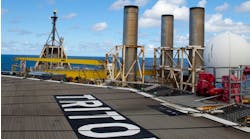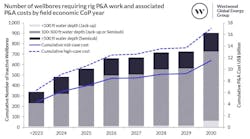More exploration on the horizon
The Black Sea is seeing renewed interest from international exploration companies, and more exploration drilling is on the horizon.
The Black Sea has been poorly explored to date, and success in the region has been limited. In recent months, however, a number of international companies have shown renewed interest, and plans are in place to drill several key exploration wells in the near future.
The Black Sea lies northeast of the Mediterranean Sea in waters belonging to Bulgaria, Romania, Ukraine, Russia, Georgia, and Turkey. Bounded by areas affected mainly by Tertiary compressive deformation, the sea is composed of two extensional basins, the western and eastern Black seas, which are separated by the Mid Black Sea High. The two rifts have coalesced in their post-rift phases to form the present single depocenter.
From the Late Eocene onward, the post-rift Black Sea basins underwent compression at their southern, northern, and eastern margins, associated with the closure of the Tethyan Ocean system. The region saw the most intense compression in the Oligocene, but the phenomenon continues today.
The Black Sea, northeast of the Mediterranean Sea with waters belonging to Bulgaria, Romania, Ukraine, Russia, Georgia, and Turkey, is seeing renewed interest from international exploration companies.
The Black Sea plays an important role for hydrocarbon transits in the region. Nearly a third of the Russian oil exports, about half of the Kazakh exports, and all of the exports from Azerbaijan cross the Black Sea and the congested Bosporus Strait, a situation that should improve slightly with the opening of the Baku-Tbilisi-Ceyhan pipeline, which will transport Caspian oil overland to the Mediterranean. Since early 2003, Russia has also exported gas to Turkey through the submarine Blue Stream pipeline, which lies under the Black Sea.
Bulgaria
The Bulgarian sector of the Black Sea is almost entirely under license held by UK Melrose Resources subsidiary, Petreco, Austria’s OMV, and Vintage of the US. All three operators are looking for partners.
Bulgaria recently awarded the Shabla block to domestic company PDNG-Sofia Corp., and the remaining Galata block is being offered for bidding. Galata, which Petreco contractually relinquished last October, contains Bulgaria’s first commercial offshore gas discovery made by a Texaco-led group in 1993. Galata, which began production last June, is the country’s only producing offshore field.
Recent activity on the Bulgarian Black Sea shelf includes 3D seismic acquisitions recorded by Petreco, OMV, and Vintage over their respective blocks in the summer of 2003. Of these three operators, Petreco is the only one that has drilled.
The company completed two development wells on the Galata field in January 2004. Three exploration wells drilled between 2003 and the end of 2004 were unsuccessful and were consequently plugged and abandoned.
Petreco reportedly is planning to drill two more development wells in the eastern part of the Galata field this summer. The company’s next exploration well, between the Samotino More and Samotino Iztok structures, will follow this fall.
About 20 wells have been drilled to date in the Bulgarian part of the Black Sea, including 17 new-field wildcats, one outpost, and two development wells.
Romania
Petrom, the former Romanian state oil and gas company, holds the Romanian portion of the Black Sea. Since December 2004, Petrom has been held by OMV (Austria) and Paladin of the UK. The central area of the Romanian offshore and the northernmost part near the Danube River delta remain unallocated, and Centaur relinquished the southwestern sector in late 2003. The maritime boundary with Ukraine is still unresolved.
Approximately 100 wells have been drilled in the Romanian sector of the Black Sea to date, including about 70 exploration and 30 development/injection wells. Three producing fields lie in this sector and are operated by Petrom. The fields include Lebada Est, an oil, gas, and condensate field discovered in 1980, and two oil and gas fields, Lebada Vest, discovered in 1984, and Pescarus, discovered in 1999. Petrom’s Sinoe oil and gas discovery, made in 1987, and Paladin’s Doina gas discovery, which Enterprise Oil made in 1995, are being appraised. Although Petrom has made two more discoveries in the area - Portita 11 in 1990 and Cobalcescu 70 in 1997 - no further activity has been reported.
Recent activity on the Romanian shelf includes Petrom’s two wildcats in the delta structure, which were both P&A’d in early 2005. Continued development drilling on the Pescarus field has yielded two oil producers and one non-commercial oil well since late 2003.
Petrom has not announced its plans for its Black Sea holdings, and Paladin’s operations remain suspended pending the resolution of the Romania-Ukraine maritime boundary dispute.
Ukraine
State company Chornomornaftogaz discovered eight gas-condensate fields in the shallow water region offshore Ukraine and identified several drillable prospects. The company is looking for a strategic partner, but no legitimate deals have emerged thus far, despite several primary agreements signed over the last few years with Petrobras, OMV, Shelton Canada, JKX of the UK, Hunt Overseas Oil Co. of the US, and Russia’s Gazprom.
In November 2004, Chornomornaftogaz spudded a stratigraphic test on the Subbotina prospect on the shelf off the Kersh Peninsula. In 2005, the company intends to drill a wildcat on the Pallasa prospect, just south of Subbotina. In addition, two exploratory wells are planned in the northwestern part of the Black Sea shelf on the Uglovoy and Riftovyy prospects.
Russia
No wells have been drilled in the Black Sea offshore Russia. State company Rosneft has a deepwater license over the Tuapse Trough off of Novorossyisk and Tuapse. Since October 2003, Rosneft and Total have been negotiating to create a joint venture for the project, where water depth ranges from 500 m to 2,000 m. The work program includes acquisition of 2D and 3D seismic data and drilling one well.
Total already had a similar agreement with Yukos for the adjacent Shatsky ridge region (south of the Tuapse trough) in water depths ranging from 1,500 m to 2,500 m. However, in April 2004, Total decided not to pursue this venture.
The Shatsky ridge is a major elongate, largely un-deformed pre-rift high on the northern margin of the eastern Black Sea, which has at least two regional culminations. It is bounded toward the basin by a series of extensional fault terraces and is tilted toward the northeast by loading of the Greater Caucasus thrust sheets. The Tuapse Trough is a southern foreland basin to the Greater Caucasus, which is developed on top of the Shatsky Ridge.
Georgia
Georgia’s shelf can be subdivided into two sectors, with prospectivity of the northern half associated with Mesozoic deposits occurring at depths from 1,500 m to 3,500 m and prospectivity of the southern sector associated with Tertiary formations occurring at depths of 2,000 m to 3,200 m.
In June 2000, Anadarko signed a PSA for three blocks (IIa, IIb, III) with national oil company Saknavtobi and UK-independent JKX. At that time, JKX transferred the block license that it had held since 1994 to Anadarko, but retained a 4% net-profit interest. In March 2005, BP Exploration Operating Co. and Turkish Petroleum Overseas Co. (TPOC) farmed in to the acreage.
A wildcat might be drilled this year based on a 3D seismic survey acquired in the southernmost area of block III last year and on the results of a BP well drilled in the adjoining block in the Turkish Black Sea area, which is close to the border with Georgia. BP and TPAO, TPOC’s parent company, jointly hold that block.
Turkey
Only nine wells have been drilled in the Turkish sector of the Black Sea. Madison Oil Turkey Inc. (parent Toreador Resources), spudded a tenth in early May. Madison operates 14 coastal blocks, though its work focuses around its Ayazli 1 gas discovery and the surrounding South Akcakoca sub-basin, where 13 potential drilling locations and six prospects have been identified. The six prospects have a reserve potential-per-prospect ranging from 100 bcf to 1 tcf.
BP expected to spud its first exploration well, Hopa HPX 1, in June. Hopa HPX1 lies in water depths ranging from 1,500 m to 2,000 m, and was to reach an approximate 4,600 m TD. The well is in block 3534 and marks the first well drilled in deepwater since Arco’s two Limankoy wells, which were P&A’d with gas shows in 1999.
In 2004, Turkish state company TPAO shot more than 15,000 km of 2D seismic data and a 3D seismic survey covering 205 sq km of its blocks. Unfortunately, the re-award in June 2004 of TPAO’s deepwater blocks caused controversy. Madison was among the most notable challengers, despite the fact that Madison is partnered with TPAO in eight of its blocks. The dispute arose after TPAO re-awarded the licences three months after dropping them. Turkish law prohibits a company from re-applying for the same licence within 12 months of its being relinquished. Despite the questionable re-award, TPAO remains operator of the blocks.•




